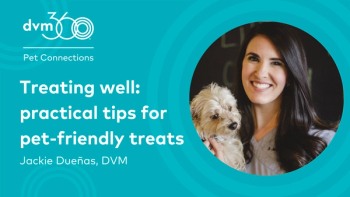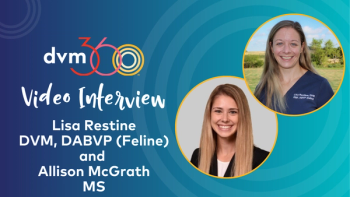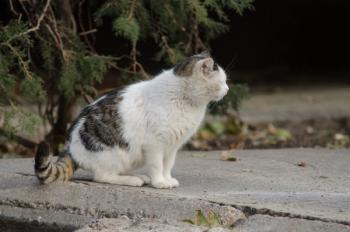
Journal Scan: Helping feline veterinary patients lose weight is a universal challenge
A large international study on feline weight loss reveals factors that are significantly associated with the likelihood that cats will shed unwanted pounds.
"What looks good today?" (adobestock/Africa Studio)Why they did it
Feline obesity is a global issue with
What they did
The investigators approached veterinary practices throughout North and South America, Asia and Europe to participate in the study. Each practice appointed a veterinarian or technician/nurse as a study investigator to recruit cat-owning clients. Indoor, solitary cats at least 12 months of age and with a body condition score (BCS) of at least 7 on a 9-point scale were eligible for the study. Eligible cats were also free from concurrent disease and receiving no medications other than routine vaccines and parasite prophylaxis. Pets that failed to accept the experimental diet and those not presented for follow-up assessments were withdrawn. Clients could also withdraw their cats voluntarily if the animal developed an unrelated illness during the study, although short-term nonsteroidal anti-inflammatory drug and antimicrobial treatments were allowed as needed.
At the enrollment visit, investigators recorded patient signalment, body weight and BCS on a 9-point scale. They also used owner responses to estimate scores for perceived activity level, quality of life and food-seeking behavior in pet cats. Study investigators used Royal Canin's Vet Follow Up software to calculate target body weight and daily food energy allocation, calculated as 222 kJ/kg/day for a weekly weight loss rate of 0.5% to 2%. Food allocation was converted automatically to a daily ration of a dry-only or mixed wet and dry Royal Canin diet. Clients measured daily food rations using an electronic gram scale or measuring cup.
Follow-up assessments were targeted at 2, 4, 8 and 12 weeks into the study to re-evaluate body weight, BCS and owner-reported data. Then Vet Follow Up software calculated each cat's weight loss rate and adjusted the feeding plan to maintain the 0.5% to 2% weekly weight loss rate.
What they found
A total of 306 veterinary practices in 25 countries recruited 710 clients to participate in the three-month weight loss study. Complete data were available for 413 cats (58%) that finished the study. Reasons for failing to complete the study included failure to present for follow-up visits, owner noncompliance, patient refusal of the experimental diet and development of unrelated medical conditions.
Participating cats included 175 spayed females, 11 intact females, 220 neutered males, and seven intact males; the median age was 6 years. Breed was mixed or unknown in 75% of the cats. Median starting body weight and BCS were 6.7 kg and 8/9, respectively. Before the study, 75% of cats were fed dry food exclusively, 25% were fed mixed wet and dry food, and less than 1% were fed wet food only. Mean starting and ending daily food allocations were 222 and 211 kJ/kg/day, respectively.
Ninety-seven percent of cats lost weight over the course of the study, while 3% either maintained or gained weight. Mean percent body weight lost after the first 2, 4, 8 and 12 weeks was 3%, 5.5%, 8.1% and 10.6%, respectively, resulting in a mean weekly weight loss rate of 0.8%. While the majority of cats lost weight, only 5% reached their target body weight and ideal BCS by the study's completion.
Logistic regression analysis revealed that certain factors were significantly associated with weight loss. Cats that were fed dry food exclusively before the study were more likely to complete the study than were other cats. Study completion rate and percentage of body weight lost were comparable between sexes and regardless of reproductive status. The percentage of weight lost was highest for cats living in Europe and South America; however, cats living in North America were most likely to complete the study.
At the initial visit, owners perceived that activity levels were higher in overweight cats with a BCS of 7 than in obese cats with BCS of 8 or 9. Clients also reported that younger cats were more active and experienced a higher quality of life throughout the study than did older cats. Overall, owners perceived that activity levels increased in 49% of cats during the study, while 46% maintained stable activity and the remainder became less active. Food-seeking behavior significantly decreased in nearly half of the cats during the study but had no relationship with age or BCS.
Take-home points
This study revealed universal challenges to weight loss in pet cats, regardless of geographic location. The average weight loss rate reported here was lower than previously reported weekly rates of 1% to 2% in research colonies, and weight loss slowed with time. Also, nearly half of all recruited cats did not complete the weight loss trial, indicating a high failure rate.
“Although successful weight loss is possible,” the authors emphasized, “many pet cats and their owners will struggle.” Thus, veterinary practitioners should communicate clearly with clients the
Flanagan J, Bissot T, Hours M-A, et al. An international multi-center cohort study of weight loss in overweight cats: differences in outcome in different geographical locations. PLoS ONE 2018;13(7):e0200414.
Article link:
Dr. Stilwell provides freelance medical writing and aquatic veterinary consulting services through her business,
Newsletter
From exam room tips to practice management insights, get trusted veterinary news delivered straight to your inbox—subscribe to dvm360.






